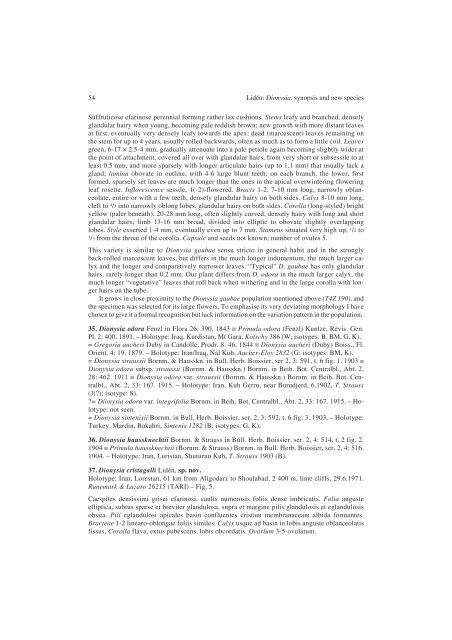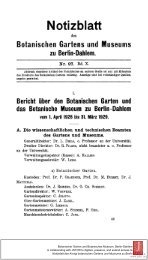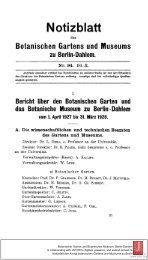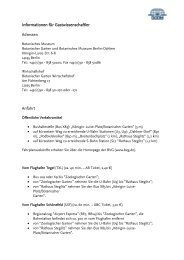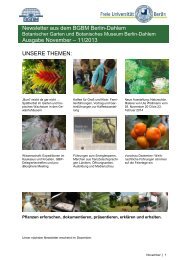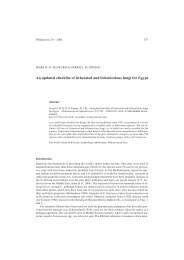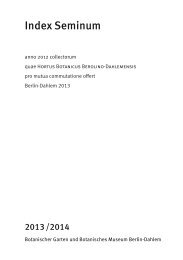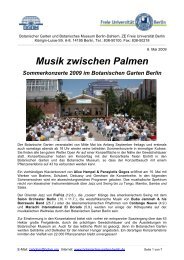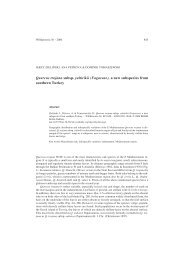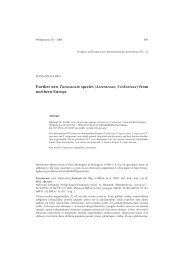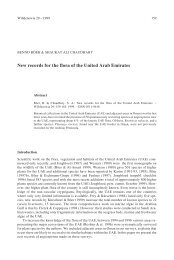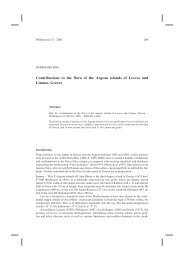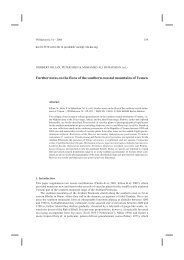The genus Dionysia (Primulaceae), a synopsis and five new species
The genus Dionysia (Primulaceae), a synopsis and five new species
The genus Dionysia (Primulaceae), a synopsis and five new species
Create successful ePaper yourself
Turn your PDF publications into a flip-book with our unique Google optimized e-Paper software.
54 Lidén: <strong>Dionysia</strong>, <strong>synopsis</strong> <strong>and</strong> <strong>new</strong> <strong>species</strong><br />
Suffruticose efarinose perennial forming rather lax cushions. Stems leafy <strong>and</strong> branched, densely<br />
gl<strong>and</strong>ular hairy when young, becoming pale reddish brown; <strong>new</strong> growth with more distant leaves<br />
at first, eventually very densely leafy towards the apex; dead (marcescent) leaves remaining on<br />
the stem for up to 4 years, usually rolled backwards, often as much as to form a little coil. Leaves<br />
green, 6-17 × 2.5-4 mm, gradually attenuate into a pale petiole again becoming slightly wider at<br />
the point of attachment, covered all over with gl<strong>and</strong>ular hairs, from very short or subsessile to at<br />
least 0.5 mm, <strong>and</strong> more sparsely with longer articulate hairs (up to 1.1 mm) that usually lack a<br />
gl<strong>and</strong>; lamina obovate in outline, with 4-6 large blunt teeth; on each branch, the lower, first<br />
formed, sparsely set leaves are much longer than the ones in the apical overwintering flowering<br />
leaf rosette. Inflorescence sessile, 1(-2)-flowered. Bracts 1-2, 7-10 mm long, narrowly oblanceolate,<br />
entire or with a few teeth, densely gl<strong>and</strong>ular hairy on both sides. Calyx 8-10 mm long,<br />
cleft to 4 /5 into narrowly oblong lobes, gl<strong>and</strong>ular hairy on both sides. Corolla (long-styled) bright<br />
yellow (paler beneath), 20-28 mm long, often slightly curved, densely hairy with long <strong>and</strong> short<br />
gl<strong>and</strong>ular hairs; limb 13-16 mm broad, divided into elliptic to obovate slightly overlapping<br />
lobes. Style exserted 1-4 mm, eventually even up to 7 mm. Stamens situated very high up, 1 /4 to<br />
1<br />
/3 from the throat of the corolla. Capsule <strong>and</strong> seeds not known; number of ovules 5.<br />
This variety is similar to <strong>Dionysia</strong> gaubae sensu stricto in general habit <strong>and</strong> in the strongly<br />
back-rolled marcescent leaves, but differs in the much longer indumentum, the much larger calyx<br />
<strong>and</strong> the longer <strong>and</strong> comparatively narrower leaves. “Typical” D. gaubae has only gl<strong>and</strong>ular<br />
hairs, rarely longer than 0.2 mm. Our plant differs from D. odora in the much larger calyx, the<br />
much longer “vegetative” leaves that roll back when withering <strong>and</strong> in the large corolla with longer<br />
hairs on the tube.<br />
It grows in close proximity to the <strong>Dionysia</strong> gaubae population mentioned above (T4Z 190), <strong>and</strong><br />
the specimen was selected for its large flowers. To emphasise its very deviating morphology I have<br />
chosen to give it a formal recognition but lack information on the variation pattern in the population.<br />
35. <strong>Dionysia</strong> odora Fenzl in Flora 26: 390. 1843 ≡ Primula odora (Fenzl) Kuntze, Revis. Gen.<br />
Pl. 2: 400. 1891. – Holotype: Iraq, Kurdistan, Mt Gara, Kotschy 386 (W; isotypes: B, BM, G, K).<br />
= Gregoria aucheri Duby in C<strong>and</strong>olle, Prodr. 8: 46. 1844 ≡ <strong>Dionysia</strong> aucheri (Duby) Boiss., Fl.<br />
Orient. 4: 19. 1879. – Holotype: Iran/Iraq, Nal Kuh, Aucher-Eloy 2832 (G; isotypes: BM, K).<br />
= <strong>Dionysia</strong> straussii Bornm. & Hausskn. in Bull. Herb. Boissier, ser 2, 3: 591, t. 6 fig. 1. 1903 ≡<br />
<strong>Dionysia</strong> odora subsp. straussii (Bornm. & Hausskn.) Bornm. in Beih. Bot. Centralbl., Abt. 2,<br />
28: 462. 1911 ≡ <strong>Dionysia</strong> odora var. straussii (Bornm. & Hausskn.) Bornm. in Beih. Bot. Centralbl.,<br />
Abt. 2, 33: 167. 1915. – Holotype: Iran, Kuh Gerru, near Burudjerd, 6.1902, T. Strauss<br />
(J(?); isotype: S).<br />
?= <strong>Dionysia</strong> odora var. integrifolia Bornm. in Beih. Bot. Centralbl., Abt. 2, 33: 167. 1915. – Holotype:<br />
not seen.<br />
= <strong>Dionysia</strong> sintenisii Bornm. in Bull. Herb. Boissier, ser. 2, 3: 592, t. 6 fig. 3. 1903. – Holotype:<br />
Turkey, Mardin, Bakahri, Sintenis 1282 (B; isotypes: G, K).<br />
36. <strong>Dionysia</strong> haussknechtii Bornm. & Strauss in Bull. Herb. Boissier, ser. 2, 4: 514, t. 2 fig. 2.<br />
1904 ≡ Primula haussknechtii (Bornm. & Strauss) Bornm. in Bull. Herb. Boissier, ser. 2, 4: 516.<br />
1904. – Holotype: Iran, Luristan, Shuturun Kuh, T. Strauss 1903 (B).<br />
37. <strong>Dionysia</strong> cristagalli Lidén, sp. nov.<br />
Holotype: Iran, Lorestan, 61 km from Aligodarz to Shoulabad, 2 400 m, lime cliffs, 29.6.1971.<br />
Runemark & Lazaro 26215 (TARI) – Fig. 5.<br />
Caespites densissimi grisei efarinosi, caulis numerosis foliis dense imbricatis. Folia anguste<br />
elliptica, subtus sparse et breviter gl<strong>and</strong>ulosa, supra et margine pilis gl<strong>and</strong>ulosis et egl<strong>and</strong>ulosis<br />
obsita. Pili egl<strong>and</strong>ulosi apicales basin confluentes cristam membranaceam albida formantes.<br />
Bracteae 1-2 linearo-oblongae foliis similes. Calyx usque ad basin in lobis anguste oblanceolatis<br />
fissus. Corolla flava, extus pubescens, lobis obcordatis. Ovarium 3-5-ovulatum.


